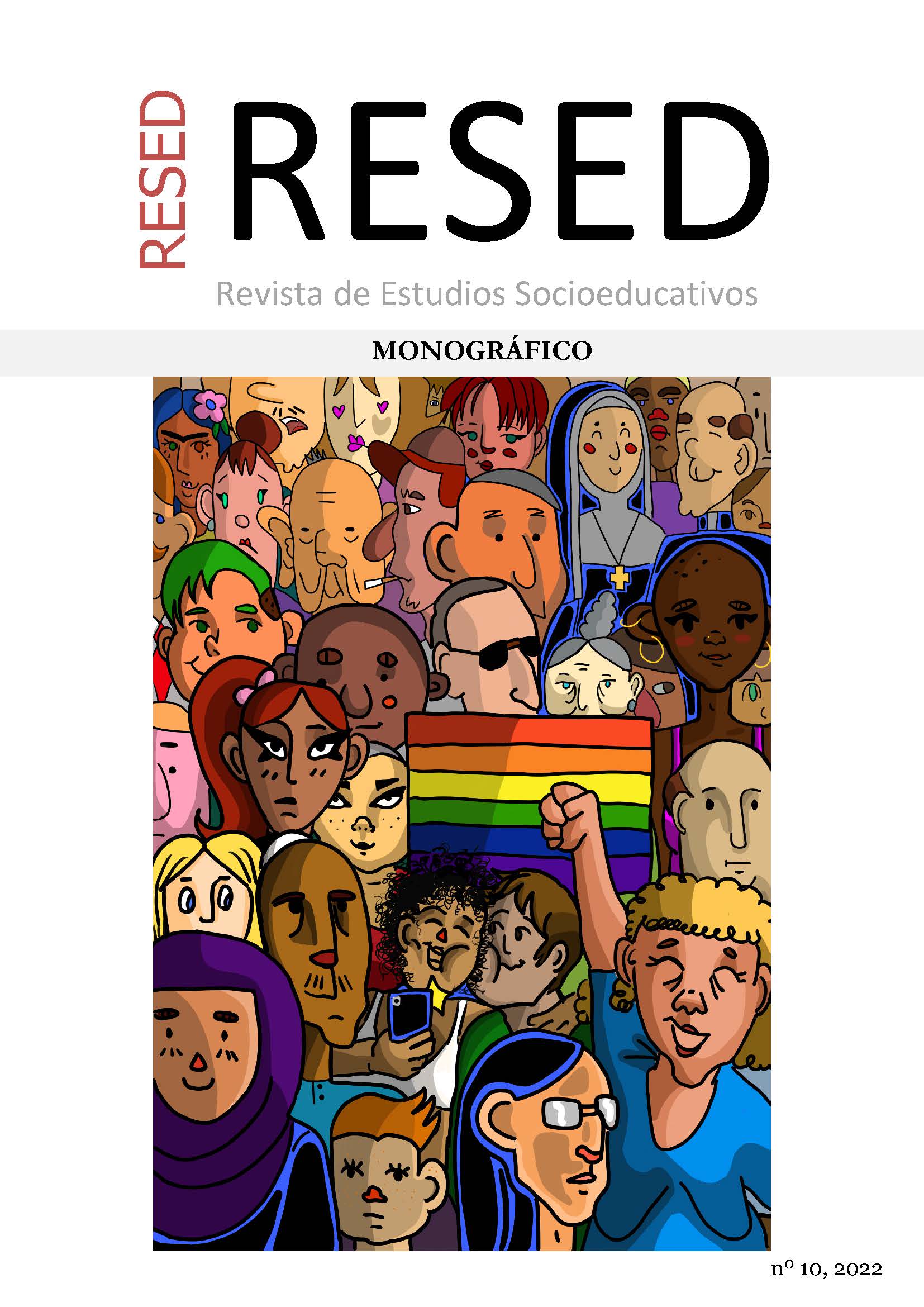Trans-formative identity. The case of a transgender and ASD adolescent, from the therapeutic approach of Alpha Therapy
The case of a transgender and ASD adolescent, from the therapeutic approach of Alpha Therapy

Info
Abstract
The objectives of this article are focused on the case study of a transgender adolescent with Asperger's Syndrome. This case is focused on the psychological approach of Alpha Therapy, with their respective stages. The methodology of this text is qualitative, specifically from the interpretive approach of symbolic interactionism to understand the articulating concepts of the analysis: body, perception, and reality. Among the conclusions, we reached that there is an interdependence between these concepts, based on the duality of identities presented by the subject, all functioning as a system on which the development of the therapeutic process and the individual himself are sustained.
Keywords
Downloads
How to Cite
License

This work is licensed under a Creative Commons Attribution-NonCommercial 4.0 International License.
References
Absi, P. (2020). El género sin sexo ni derechos: la Ley de Identidad de Género en Bolivia. Debate feminista(59), 31-47. doi:10.22201/cieg.2594066xe.2020.59.02
Amorocho Herrera, E. (2019). De la exclusión social al reconocimiento de la dignidad en los contextos educativos. Revista de Estudios Socioeducativos(7), 216-226. doi:10.25267/Rev_estud_socioeducativos.2019.i7.15
Arce Rudón, E. (4 de diciembre de 2021). Anempatía selectiva. (ACT, Entrevistador)
Attwood, T. (1997). Asperger's syndrome: A guide for parents and professionals. London: Jessica Kingsley.
Autismo Diario. (05 de diciembre de 2019). Conociendo el síndrome de Asperger. https://cutt.ly/jFeuAzD
Basante Ballesteros, M. S., & Ortiz Quevedo, J. P. (2021). Paradoja transgénero: Alteraciones emocionales más frecuentes durante la transición. Revista Derecho y Realidad, 19(37), 211-227. doi:10.19053/16923936.v19.n37.2021.13015
Bertone, M. S., Domínguez, M. S., Vallejos, M., Moauro, H., & Román, F. (2015). Neurobiología de la psicopatía. Revista Psiquiatría, 19(12), 1137-3148.
Blumer, H. (1982). El interaccionismo simbólico: Perspectiva y método. Buenos Aires: CEAL.
Caravaca Morera, J. A. (2017). El dispositivo trans: sobre realidades, complejidades y subversiones al aparato. Enfermería actual de Costa Rica, 197-209. https://cutt.ly/5FeuGV6
Cooper, K., Mandy, W., Butler, C., & Russell, A. (2021). The lived experience of gender dysphoria in autistic adults: An interpretative phenomenological analysis. Autism. doi:10.1177/13623613211039113
Dattaro, L. (2020). Largest study to date confirms overlap between autism and gender diversity. Spectrum News. https://cutt.ly/BFeuLnF
Diario El Deber. (28 de diciembre de 2018). Segip: 241 personas han cambiado de género este 2018. Bolivia. https://cutt.ly/RFeuVSL
Espinoza, M., Fernández, O. M., Riquelme, N., & Irarrázaval, M. (2019). La identidad transgénero en la adolescencia chilena: experiencia subjetiva del proceso. Psykhe, 28(2), 1-12. doi:10.7764/psykhe.28.2.1425
Fernandes, F. S. (2008). O corpo no autismo. Psic: revista da Vetor Editora, 9(1), 109-114. Obtenido de pepsic.bvsalud.org/scielo.php?script=sci_arttext&pid=S1676-73142008000100013&lng=pt&tlng=pt.
Fernández Riquelme, S. (. (2017). Si las piedras hablaran. Metodología cualitativa de Investigación en Ciencias Sociales. La Razón Histórica,(43), 4-30. https://cutt.ly/GFeu1Cd
González-Alba, B., Cortés-González, P., & Mañas-Olmo, M. (2019). El diagnóstico del Síndrome de Asperger en el DSM-V. Ajayu Órgano de Difusión Científica del Departamento de Psicología UCBSP, 17(2), 332-353. https://cutt.ly/1Feu3GT
Grosso Funes, M. L. (2021). El autismo en los manuales diagnósticos internacionales: cambios y consecuencias en las últimas ediciones. Revista Española de Discapacidad, 9(1), 273-283. doi:10.5569/2340-/5104.09.01.15
Guzmán-González, M.; Barrientos, J.; Saiz, J. L.; Gómez, F.; Cárdenas, M.; Espinoza-Tapia, R.; Bahamondes, J.; Lovera, L. & Giami, A. (2020). Salud mental en población transgénero y género no conforme en Chile. Revista Médica de Chile, 148(8), 1113-1120. doi:10.4067/S0034-98872020000801113
Hérvas Zúñiga, A., & García, N. M. (2020). Los trastornos del espectro autista. Pediatría integral, 24(6), 325.e1–325.e21. https://cutt.ly/3Feu6WJ
Juárez Tito, E., Arce Rudón, E., & Pereira de Carvalho, F. (2017). Anempatía selectiva: un nuevo concepto en salud mental. Ajayu Órgano de Difusión Científica del Departamento de Psicología UCBSP, 15(1), 1-14. https://cutt.ly/gFeieUY
Levin, E. (2000). A clínica psicomotora: o corpo na linguagem (3ª ed.). (J. Jerusalinsky, Trad.) Petrópolis: Vozes.
Mustaffa Quiros, J. (14 de 10 de 2020). Identidad de género, la carrera por el alcance de los derechos. Verdad con tinta. https://cutt.ly/IFeiu0Z
Nabbijohn, A.N.; van der Miesen, A.I.; Santarossa, A.; Peragine, D.; A.L., de Vries; , Popma, A.; Lai, M.C. & VanderLaan, D.P. (2019). Gender Variance and the Autism Spectrum: An Examination of Children Ages 6-12 Years. Autism Develpment Disorders, 49(4), 1570-1585. doi:10.1007/s10803-018-3843-z
Nieto, J. A. (1999). El individuo, el cuerpo y el transgénero. Revista de Psicoterapia, 10(40), 49-60. doi:10.33898/rdp.v10i40.795
Nobili, A., Glazebrook, C., Pierre Bouman, W., Glidden, D., Baron-Cohen, S., Allison, C., . . . Arcelus, J. (2018). Autistic Traits in Treatment-Seeking Transgender Adults. Journal of Autism and Developmental Disorders volume, 3984–3994. doi:10.1007/s10803-018-3557-2
Pérez Guirao, F. J. (2014). Identidad y diversidad cultural. Una visión antropológica del género y la sexualidad. Revista de Estudios Socioeducativos, 1(2), 12-32. doi:10.25267/Rev_estud_socioeducativos.2014.i2.02
Ramírez Tovar, G. E., & García Rodríguez, R. E. (2018). La modificación del cuerpo transgénero: experiencias y reflexiones. Andamios, 15(37), 303-324. https://cutt.ly/wFeisLk
Reisner, S.L.; Poteat, T.; Keatley, J.; Cabral, M.;, Mothopeng, T.; Dunham, E.; Holland, C.; Max, R. & Baral, S. (2016). Global health burden and needs of transgender populations: a review. The Lancet, 388(10042), 412-426. doi:10.1016/S0140-6736(16)00684-X
Ryan, S., & Raisanen, U. (2009). "It’s like you are just a spectator in this thing": Experiencing social life the ‘aspie’ way. Emotion, Space and Society(1), 135-142. doi:10.1016/j.emospa.2009.02.001
Sánchez Torrejón, B. (2021). La formación del profesorado de Educación Primaria en diversidad sexo-genérica. Revista Electrónica Interuniversitaria de Formación del Profesorado, 24(1), 253-266. doi:10.6018/reifop.393781
Sevilla Rodríguez, A. J., Aparicio García, M. E., & Gras, R. (2019). La salud de adolescentes y adultos transgénero: revisión sistemática desde la perspectiva de género. Revista Iberoamericana de Diagnóstico y Evaluación - e Avaliação Psicológica, 1(50),5-20, https://cutt.ly/VFeijsQ
Sosa-Sánchez, I. (2021). Cuerpo, self y sociedad: una reflexión desde la fenomenología y el interaccionismo simbólico. Iberoforum. Revista de Ciencias Sociales, 1(2), 1-18. doi:10.48102/if.2021.v1.n2.162
Spectrumnews. (13 de febrero de 2019). Un estudio refuerza el vínculo del autismo con la disforia de género.


